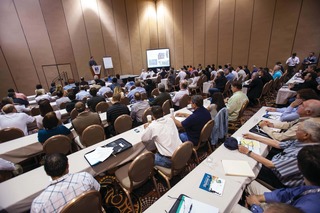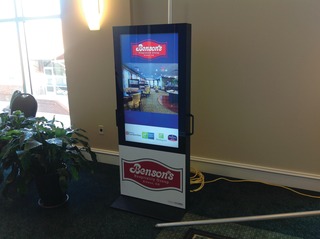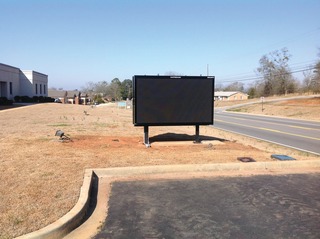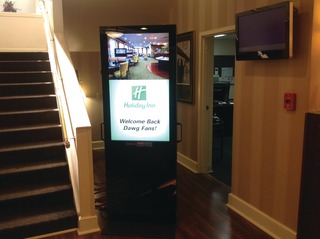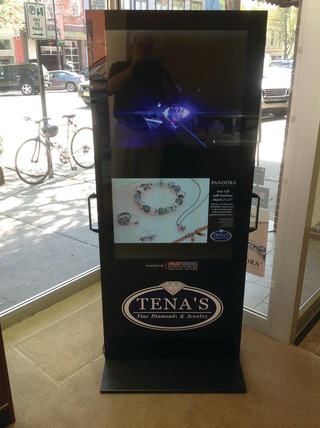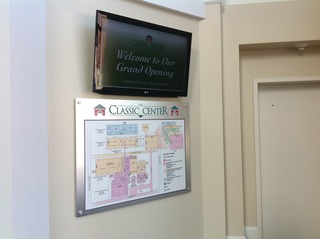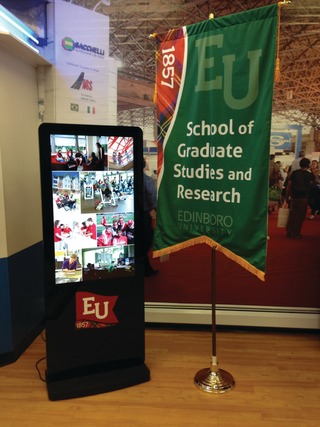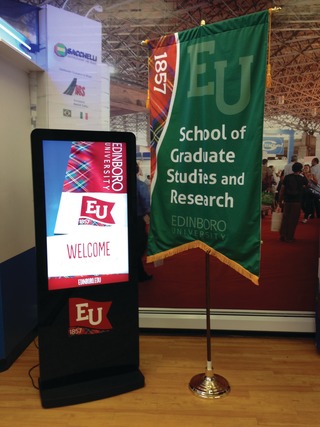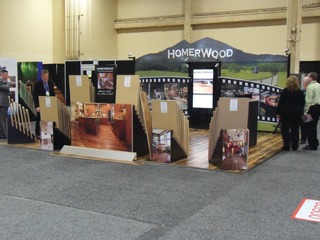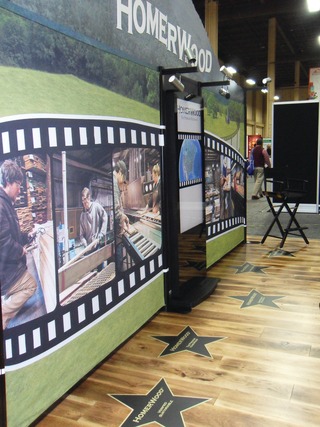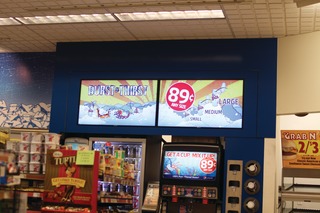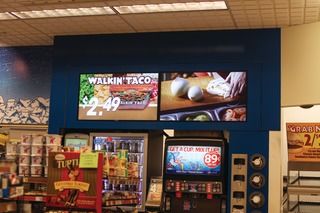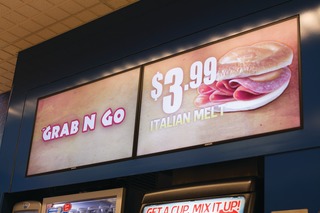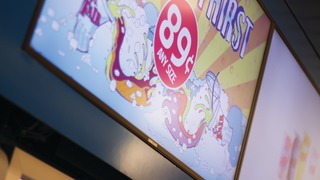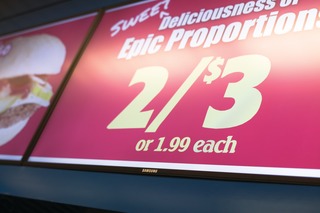Cutting Your Teeth On DDS
While elaborate print/DDS combos are still rare, sign shops are beginning to explore the basics of digital signage.
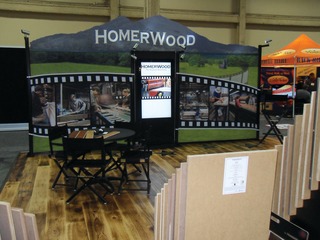
Picture if you will: a seafood restaurant has a large printed image of a fish on the wall. How do you communicate that the fish is fresh? Integrate moving graphics—dynamic digital signage—with the printed image. A video display behind the fish’s eye, for example, conveys movement.
This was an example cited by Joseph Mergui, president and CEO of Caldera, back at FESPA London in 2013. Caldera had been showing—among other products—its Variable Display, a combination of hardware and software that drives a video display enabling dynamic digital signage (DDS). It was one of the first—if not the first—“digital signage in a box” systems to appear, putting DDS within affordable reach of even small shops.
While these kinds of elaborate print/DDS combos are still rare, sign shops and other wide-format print service providers are beginning to explore the basics of digital signage. Although some of the bigger companies like FastSigns have been involved in DDS for at least a decade, it is only in the past five years or so that digital signage has appeared on the industry’s collective radar. We’re still in the early adopter stage, but growth is moving swiftly. As a result, best practices are still very much in flux.
“That’s one of the sticking points in the industry,” said Glenn Feder, director of business development for the International Sign Association (ISA), referring to emerging best practices for digital signage. “No matter where you look, it’s critically important and people are a bit uncertain of how to go forward with it. There are so many variables and hundreds of vendors.”
ISA’s Sign Expo shows, held every spring alternately in Las Vegas and Orlando, have been focusing extensively on digital signage, and ISA’s cosponsoring of the Wide-Format Pavilion at this year’s Graph Expo has also helped raise the profile of DDS.
Environment-Friendly Signage
When we speak of best practices for digital signage, in some ways, we shouldn’t think that they are anything dramatically different from best practices for traditional signage. If there is one important consideration when it comes to DDS, it’s that it should harmonize with preexisting signage.
Digital signage, said Justin Ryan, author of the new book Digital Signage Power (www.digitalsignagepower.com), “should be suited to the environment that it’s going to be in. If you’re in a quiet space, you don’t want a noisy digital sign. You also want to tailor the text to really match other signage.” Ultimately, the branding should remain the same. “Stick to the existing graphics and color scheme they [customers] already have. That way it complements what they have, and isn’t an eyesore.”
Print signage professionals—designers, printers, and installers—are experts on the aesthetics of signage, from pleasing and effective color schemes, to typography, to backgrounds, to consistency of branding. Digital signage adds an extra dimension—perhaps audio, video, and animation—but when all’s said and done, it’s really just text and graphics.
Signage As a Service
If there is one major difference between traditional signage and digital signage, it’s that the latter lends itself to a service-based business model, rather than just a production- or task-based model.
Burney Dobbs is owner of Athens, Ga.’s FastSigns franchise, and has been offering digital signage solutions for about 10 years. FastSigns of Athens has completed high- volume deployments for the local civic center, local universities and medical centers, and banks, as well as simple single-screen digital signs for small mom-and-pop shops—and everything in between. A large component of a digital signage project is selling the ongoing maintenance of the signs as a service. That maintenance can involve creating new templates, doing a rebrand, and checking on the status of the signage.
“We’ve always got something to go back to [customers] with,” said Dobbs. “‘Do you need more templates?’ ‘Do you want to change the look of the signage?’ We touch base with our customers about once a month, just to see how they’re doing.”
There is also updating the content.
“Content is king and that’s why so many people come to FastSigns, because I employ graphic artists,” said Dobbs. “In order for digital signs to work, you have to constantly change your content. We not only create content, we manage content.”
“It gets you to do consultative selling,” Dobbs added, comparing it to the strategy employed by razor manufacturers. “They’ll give you the razor, but they just want you to buy the razor blades forever. That’s what the digital sign does for the sign business.”
Buying Quality Ingredients
“Everybody says ‘content is king,’ but it’s often the last thing people think of because of the intimidation factor of the hardware,” said Levi Stutzman, consultant and digital signage specialist for FastSigns Erie-PA. “We see how complex hardware is. That’s where a lot of people are scared away.”
Any print shop owner can probably tell you a story or two about how they thought they were getting a deal on a piece of equipment and, once it was on the shop floor it quickly, shall we say, failed to live up to expectations. The situation is no different with digital signage. Just like printing equipment that spends more time being repaired than productively operating will be a liability, so, too, will be a DDS system you install that crashes every five minutes or requires the electronic equivalent of constant handholding.
Another best practice for DDS is to select the right components. “I always want to sell people a good physical product,” said Stutzman. “A screen that’s not going to crash after six months, a computer that’s not going to overheat and break down every couple of weeks. In the end, I want my content to be what sells it.”
As the technology advances, some of the problems that DDS deployers and installers have had to fight with are falling by the wayside. One potential solution is so-called all-in-one units that include the media player and the software built right into the display. “The less vendors you have to involve, the cleaner the solution will be,” said Ryan, who had cut his teeth in the late 2000s doing IT for a financial services company and being charged with the responsibility to research, acquire, and install a large-scale DDS system. With all-in-one units, there are no hardware incompatibilities since everything is integrated. That said, however, Ryan cautions against becoming too fixated on your own preferences as a DDS provider. “You have to see the project through the customer’s eyes, and not the product you want to sell and with which you’re most comfortable.” Just like the content of the digital signage has to harmonize with the customer’s overall environment, so, too, does the technology need to be compatible with what the customer wants to accomplish with the DDS deployment. If it’s a simple menu behind a food counter, you don’t need a massive network of 100 connected multi-zone displays.
So it’s not just about using quality ingredients, but using the appropriate ingredients.
Strange Bedfellows
Providing both print and digital signage doesn’t just ensure consistency of branding and harmony of design elements, but is also good for business: you can sell a DDS deployment to print customers, and print signage (or other printed materials) to DDS customers.
“Almost everyone that we’ve sold digital signs to, they’ve bought all their banners and all their other signage from us,” said FastSigns of Athens’ Dobbs. “[DDS] opens up the door to the other products that you sell.”
One key is to understand how each media platform—print or digital—has its own unique strengths. Think about a physical location, like a retail shop or office space. You’ll obviously want to print the “background branding” such as wallpaper or other décor, “but every day you have new clients, testimonials, and graphics that you can put on a TV,” said Sébastien Hanssens, vice president for marketing and communications for Caldera. Those elements can easily change from day to day. But, he said, “you can’t change the print every day.”
It doesn’t end there. There is the possibility to mix print with digital signage. If you recall this feature’s lede, highly creative individuals can do some really exciting and cutting-edge things by integrating digital signage into printed signage.
“People today still think digital or they still think print,” said Hanssens. “They don’t think of mixing the content. A lot of people just think that the TV is a menu board. They don’t think concept. That’s the tough part.”
In the example of the printed fish with the digitally displayed eye, the digital portion isn’t a “sign” per se; rather, it’s a moving image that communicates a message in a more abstract way. You’re conveying the idea that the fish is fresh by having some portion of it move. Thinking in that way can be quite different from thinking about what we now know as “traditional digital signage.” “When you mix the print and the digital, it’s good when it’s a full concept and not just a TV on a wall,” said Hanssens. “It’s pretty easy to mix the two; you just need to have the right idea and the right execution. Not many people are there yet. They think of digital signage as a square on a wall.”
Caldera demonstrated just this concept at Viscom Paris last September, with half of its booth dedicated to the Caldera WineBar, which included not just complimentary wine tastings, but also examples of how print and digital media can be integrated in the same graphics—using Caldera’s Variable Display DDS package.
The Road Ahead
Perhaps we’re getting ahead of ourselves—and certainly ahead of where most people are in their thinking about DDS. But it’s an exciting road ahead, and as the technology continues to evolve, it will open up even more creative applications, and opportunities for creative shops.


